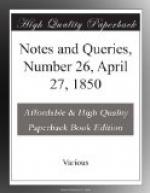“Concerning the second, viz. the matter or species whereof the current coin of this kingdom hath been made, it is gold or silver, but not altogether pure, but with an allay of copper, at least from the time of King H. I. and H. II., though possibly in ancienter times the species whereof the coin was made might be pure gold or silver; and this allay was that which gave the denomination of Sterling to that coin, viz. Sterling Gold, or Sterling Silver. Wherein there will be inquirable,
“1. Whence that denomination came?
“2. How ancient that denomination was?
“3. What was the allay that gave silver that denomination?
“For the former of these
there are various conjectures, and
nothing of certainty.
“Spelman supposeth it to take that denomination from the Esterlings, who, as he supposeth, came over and reformed our coin to that allay. Of this opinion was Camden. A Germanis, quos Angli Esterlings, aborientali situ, vocarunt, facta est appellatio; quos Johannes Rex, ad argentum in suam puritatem redigendam, primus evocavit; et ejus modi nummi Esterlingi, in antiquis scripturis semper reperiuntur. Some suppose that it might be taken up from the Starre Judaeorum, who, being the great brokers for money, accepted and allowed money of that allay for current payment of their stars or obligations; others from the impression of a starling, or an asterisk upon the coin. Pur ceo que le form d’un Stare, dont le diminutive est Sterling, fuit impressit on stamp sur ceo. Auters pur ceo que le primer de cest Standard fuit coyn en le Castle de Sterlin in Scotland pur le Roy Edw. I. And possibly as the proper name of the fourth part of a Peny was called a Farthing, ordinarily a Ferling; so in truth the proper name of a Peny in those times was called a Sterling, without any other reason of it than the use of the times and arbitrary imposition, as other names usually grow. For the old Act of 51 H. III., called Compositio Mensurarum, tells us that Denarius Anglice Sterlingus dicitur; and because this was the root of the measure, especially of Silver Coin, therefore all our Coin of the same allay was also called Sterling, as five Shillings Sterling, five Pounds Sterling.
“When this name of Sterling came first in is uncertain, only we are certain it was a denomination in use in the time of H. III. or Ed. I. and after ages. But it was not in use at the time of the compiling of {412} Doomsday, for if it were we should have found it there where there is so great occasion of mention of Firmes, Rents, and Payments. Hovended in Rich. I fol. 377. b. Nummus a Numa, que fuit le primer Roy que fesoit moneies en Rome. Issint Sterlings, alias Esterlings, queux primes fesoient le money de cest Standard en Engleterre.”—Sheriffs’ Accompts, p. 5-9.
So much for the derivation of Sterling, which evidently applied originally to the metal rather than to a coin. May I be allowed to hazard a suggestion as to the origin of peny, its synonym? They were each equivalent to the Denarius.




